|
|
 |
|
Calanoida ( Order ) |
|
|
|
Arietelloidea ( Superfamily ) |
|
|
|
Arietellidae ( Family ) |
|
|
|
Paramisophria ( Genus ) |
|
|
| |
Paramisophria platysoma Ohtsuka & Mitsuzumi, 1990 (F,M) | |
| | | | | | | Ref.: | | | Ohtsuka & Mitsuzumi, 1990 (p.88, figs.F,M, organes cuticulaires); Huys & Boxshall, 1991 (p.49); Ohtsuka & al., 1994 (p.158,160); Chihara & Murano, 1997 (p.720, Pl.: 54: F,M) | 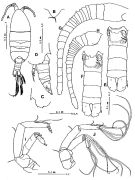 issued from : S. Ohtsuka & C. Mitsuzumi in Bull. Plankton Soc. Japan, 1990, 36 (2). [p.89, Fig.1]. Female (from Tanabe Bay): A, habitus (dorsal); B, rostrum ventral view); C, 5th toracic segment (lateral right side); D, 5th thoracic segment with P5 and urosome (lateral left side); E, F, urosome (ventral; copulatory pores indicated by arrows; E: holotype, F: paratype); G, left A1 (all elements omitted); H, right A1 (all elements omitted); I, right A2; J, left A2. Nota: Prosome considerably asymmetrical with left side compressed and right one smoothly curved in dorsal view. Head and 1st thoracic segment separated, Th4 and Th5 fused. Urosome 4-segmented. Genital segment asymmetrical, with right ventro-lateral and left ventral oviduct openings; copulatory pore located on left ventro-lateral side. left A1 longer than right; both 21-segmented. Antennae 2 asymmetrical. Md symmetrical
|
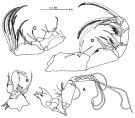 issued from : S. Ohtsuka & C. Mitsuzumi in Bull. Plankton Soc. Japan, 1990, 36 (2). [p.90, Fig.2]. Female: A, Md; B, Mx1; C, Mx2; D, Mxp. Nota: Md symmetrical; gnathobase with 4 teeth; endopod absent; exopod 4-segmented. Mx1 symmetrical; gnathobase with 4 teeth and short pointed process; 1st outer lobe bearing 8 setae; endopod bulbous, bearing 2 small setae of unequal lengths; exopod fused with basipod 2, bearing 3 plumose setae. Mx2 symmetrical (similar in armature to that of P. itoi); 5th inner lobe having a strong spine
|
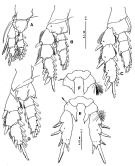 issued from : S. Ohtsuka & C. Mitsuzumi in Bull. Plankton Soc. Japan, 1990, 36 (2). [p.91, Fig.3]. Female: A, P1 (posterior); B, P2 (posterior); C, P3 (anterior); D, P4 (posterior); E, P5 (anterior); F, basipods of P5.
|
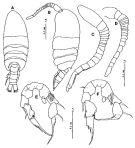 issued from : S. Ohtsuka & C. Mitsuzumi in Bull. Plankton Soc. Japan, 1990, 36 (2). [p.92, Fig.4]. Male: A, habitus (dorsal); B, idem (lateral left side); C, left A1 (all elements omitted); D, right A1 (all elements omitted); E, F, P5 (anterior view; E: paratype, F: allotype). Nota: Prosome asymmetrical as in female. Urosome 5 segmented. Left A1 geniculate, 20-segmented (segments 16 and 17 bearing low lamella along anterior margin, segment 18 with 2 low lamellae anteriorly, terminal 2 segments incompletely fused, articulation between segments 17 and 18; right A1 21-segmented. Remarks: Legs 5 of both sexes vary morphologically.
|
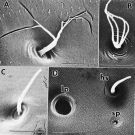 issued from : S. Ohtsuka & C. Mitsuzumi in Bull. Plankton Soc. Japan, 1990, 36 (2). [p.94, Pl. I]. Four types of integumental organs of the cephalothorax (SEM photomicrographs). Scale bar = 0.005 mm. A, B: Divergent-hair sensillum; C, single-hair sensillum; D, three types of integumental organs: Ip = circular pore; sp = circulal pore, small type; hs = single-hair sensillum.
|
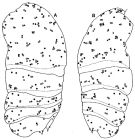 issued from : S. Ohtsuka & C. Mitsuzumi in Bull. Plankton Soc. Japan, 1990, 36 (2). [p.95, Fig.5]. Female: shematic illustration of the location of 4 types of integumental organs on cephalothorax (lateral views: A, left side; B, right side). white o: circular pore (small type); black o: circular pore (large type); white triangle: divergent-hair sensillum; black triangle: single-hair sensillum.
|
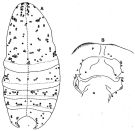 issued from : S. Ohtsuka & C. Mitsuzumi in Bull. Plankton Soc. Japan, 1990, 36 (2). [p.96, Fig.6]. Female: Schematic illustration of the location of 4 types of integumental organs on cephalothorax (dorsal view). A: dorasl view (median line indicated by broken line; B, postero-dorsal view of pediger 5; G, genital segment; P, pedigers 4 and 5. Symbols the same as in Fig.5.
|
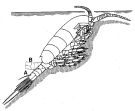 issued from : S. Ohtsuka & C. Mitsuzumi Bull. Plankton Soc. Japan, 1990, 36 (2). [p.98, Fig.7]. Schematic illustration of the swimming position with the compressed left lateral side parallel to the bottom. A, B, position of the urosome in swimming and resting, respectively.
Nota: The asymmetrical parts of the copepod body seem to be adapted for the behavior in its habitat. The gut content analysis revealed that the copepods fed carnivorously on epibenthic harpacticoids.
|
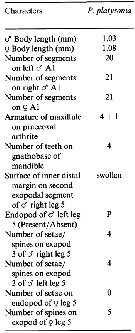 Issued from : B.-J. Lim & G.-S. Min in J. Nat. Hist., 2014, 48 (9-10). [p.532, Table 3]. Morphological characteristics. Nota: Compare within Paramisophia species of northeastern Asia: See P. itoi, P. sinjinensis, P. japonica, P. sinica, P. koreana.
| | | | | NZ: | 1 | | |
|
Distribution map of Paramisophria platysoma by geographical zones
|
| | | | | | | Loc: | | | East China Sea (Kume Is., Japan) | | | | N: | 1 | | | | Lg.: | | | (298) F: 1,08; M: 1,03; {F: 1,08; M: 1,03} | | | | Rem.: | epibenthic , coastal. | | | Last update : 27/01/2015 | |
|
|
 Any use of this site for a publication will be mentioned with the following reference : Any use of this site for a publication will be mentioned with the following reference :
Razouls C., Desreumaux N., Kouwenberg J. and de Bovée F., 2005-2025. - Biodiversity of Marine Planktonic Copepods (morphology, geographical distribution and biological data). Sorbonne University, CNRS. Available at http://copepodes.obs-banyuls.fr/en [Accessed June 04, 2025] © copyright 2005-2025 Sorbonne University, CNRS
|
|
 |
 |












